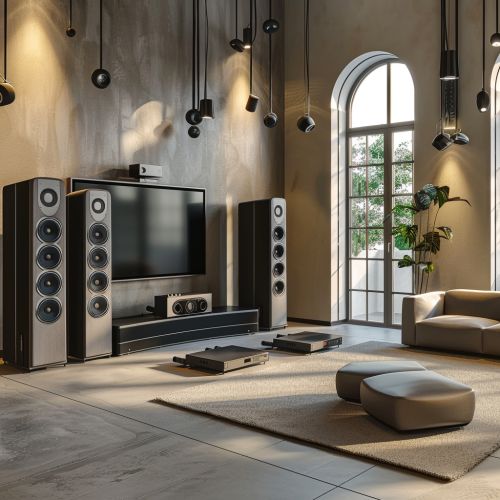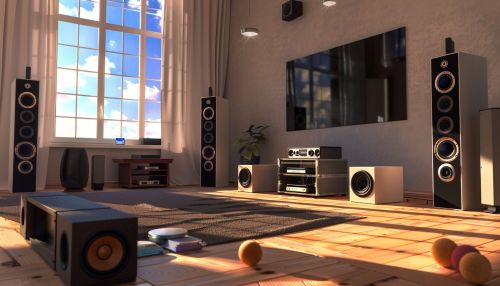Object-Based Audio
Object-Based Audio
Object-based audio is an advanced audio technology that allows for the creation, manipulation, and playback of audio elements as discrete objects. Unlike traditional channel-based audio, which relies on fixed speaker configurations, object-based audio provides a more flexible and immersive listening experience by enabling audio objects to be dynamically positioned in a three-dimensional space. This technology is widely used in various applications, including cinema, broadcasting, virtual reality, and gaming.


Overview
Object-based audio represents a significant shift from traditional audio formats. In conventional channel-based systems, audio is mixed and delivered through predefined channels (e.g., stereo, 5.1 surround sound). In contrast, object-based audio treats individual sounds as separate entities or "objects" that can be independently controlled and positioned within a three-dimensional sound field. This approach allows for greater precision and flexibility in sound design and reproduction.
The core components of object-based audio include:
- **Audio Objects**: Discrete sound elements that can be individually manipulated.
- **Metadata**: Information that describes the properties and behavior of audio objects, such as their position, movement, and volume.
- **Rendering Engine**: A system that interprets the metadata and renders the audio objects in real-time based on the listener's environment and speaker configuration.
Historical Development
The concept of object-based audio has its roots in the early experiments with spatial audio and 3D sound. However, it gained significant traction with the advent of digital audio technologies and the increasing demand for immersive audio experiences. Key milestones in the development of object-based audio include:
- **Ambisonics**: An early approach to spatial audio that aimed to capture and reproduce sound from all directions. Although not object-based, Ambisonics laid the groundwork for future developments in 3D audio.
- **Wave Field Synthesis (WFS)**: A technique that uses a large array of speakers to create a sound field. WFS can be considered a precursor to object-based audio as it allows for precise control over sound localization.
- **Dolby Atmos**: Introduced in 2012, Dolby Atmos is one of the most prominent object-based audio formats. It allows for up to 128 audio objects and supports a wide range of speaker configurations.
- **MPEG-H Audio**: A standard developed by the Moving Picture Experts Group (MPEG) that supports object-based audio and is widely used in broadcasting and streaming applications.
Technical Aspects
Object-based audio relies on several technical components to achieve its flexibility and precision. These include:
Audio Objects
An audio object is a self-contained sound element that can be independently manipulated. Each object consists of an audio signal and associated metadata. The metadata describes various attributes of the object, such as its position, movement, and volume. This allows for dynamic control over the object's behavior in a three-dimensional space.
Metadata
Metadata plays a crucial role in object-based audio. It provides the necessary information for the rendering engine to accurately position and manipulate audio objects. Common types of metadata include:
- **Positional Metadata**: Describes the location of the audio object in a three-dimensional space.
- **Dynamic Metadata**: Describes changes in the object's position, movement, and other attributes over time.
- **Behavioral Metadata**: Describes how the object should interact with the environment, such as reflections and occlusions.
Rendering Engine
The rendering engine is responsible for interpreting the metadata and rendering the audio objects in real-time. It takes into account the listener's environment, speaker configuration, and other factors to deliver an immersive audio experience. The rendering engine can adapt the audio output to different playback systems, ensuring consistent quality across various devices.
Applications
Object-based audio has a wide range of applications across different industries. Some of the key areas where this technology is used include:
Cinema
In the cinema industry, object-based audio enhances the movie-watching experience by providing a more immersive and realistic sound environment. Technologies like Dolby Atmos and DTS:X are commonly used in theaters to deliver object-based audio. These systems allow sound designers to place audio objects precisely within the theater, creating a more engaging experience for the audience.
Broadcasting
Object-based audio is increasingly being adopted in broadcasting to improve the quality and flexibility of audio content. MPEG-H Audio, for example, is used in various broadcasting standards, including ATSC 3.0 and DVB. This technology allows broadcasters to deliver personalized audio experiences, such as adjusting the dialogue level or selecting different language tracks.
Virtual Reality and Gaming
In virtual reality (VR) and gaming, object-based audio is essential for creating immersive and interactive soundscapes. By accurately positioning audio objects within the virtual environment, developers can enhance the sense of presence and realism. Technologies like Oculus Audio and Steam Audio leverage object-based audio to deliver spatial sound in VR applications.
Music Production
Object-based audio is also making its way into music production. Artists and producers can use this technology to create more dynamic and immersive music experiences. For example, Dolby Atmos Music allows for the creation of music tracks with spatial audio elements, providing listeners with a more engaging and enveloping sound.
Benefits and Challenges
Object-based audio offers several benefits over traditional audio formats, but it also presents certain challenges.
Benefits
- **Flexibility**: Object-based audio allows for greater flexibility in sound design and reproduction. Audio objects can be dynamically positioned and manipulated, enabling more creative and immersive experiences.
- **Personalization**: This technology enables personalized audio experiences, such as adjusting the dialogue level or selecting different audio tracks based on user preferences.
- **Consistency**: Object-based audio ensures consistent quality across different playback systems. The rendering engine adapts the audio output to the listener's environment and speaker configuration, providing a uniform experience.
Challenges
- **Complexity**: The creation and manipulation of audio objects require advanced tools and expertise. Sound designers and engineers need to be familiar with the technical aspects of object-based audio to fully leverage its capabilities.
- **Compatibility**: Ensuring compatibility across different playback systems and devices can be challenging. The rendering engine must be able to adapt the audio output to various configurations, which requires robust and flexible algorithms.
- **Bandwidth**: Object-based audio can require more bandwidth compared to traditional audio formats, especially when delivering high-quality audio objects and metadata. This can be a concern for streaming and broadcasting applications.
Future Directions
The future of object-based audio looks promising, with ongoing advancements in technology and increasing adoption across various industries. Some of the key trends and developments to watch for include:
- **Standardization**: Efforts are underway to develop standardized formats and protocols for object-based audio. This will help ensure compatibility and interoperability across different systems and devices.
- **Artificial Intelligence**: AI and machine learning are being explored to enhance the capabilities of object-based audio. For example, AI algorithms can be used to automate the creation and manipulation of audio objects, making the process more efficient and accessible.
- **Augmented Reality**: Object-based audio is expected to play a significant role in augmented reality (AR) applications. By accurately positioning audio objects within the real world, AR experiences can be made more immersive and interactive.
